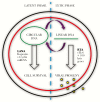Experience with Kaposi Sarcoma Herpesvirus Inflammatory Cytokine Syndrome in a Large Urban HIV Clinic in the United States: Case Series and Literature Review
- PMID: 29766014
- PMCID: PMC5946878
- DOI: 10.1093/ofid/ofx196
Experience with Kaposi Sarcoma Herpesvirus Inflammatory Cytokine Syndrome in a Large Urban HIV Clinic in the United States: Case Series and Literature Review
Abstract
In 2010, a new entity, characterized by the classical signs and symptoms of Kaposi sarcoma herpesvirus-associated multicentric Castleman's disease (KSHV-MCD) in the absence of pathologic evidence of MCD, was described in individuals living with HIV. This syndrome was named KSHV inflammatory cytokine syndrome (KICS). It carries mortality rates of up to 60%. To date, there are no standard therapies. Treatment regimens studied in clinical trials for MCD disease are used in cases of KICS.
Keywords: HIV; KICS; KSHV inflammatory cytokine syndrome.
Figures


References
-
- Pinzone MR, Berretta M, Cacopardo B, Nunnari G. Epstein-barr virus- and Kaposi sarcoma-associated herpesvirus-related malignancies in the setting of human immunodeficiency virus infection. Semin Oncol 2015; 42:258–71. - PubMed
Publication types
LinkOut - more resources
Full Text Sources
Other Literature Sources

